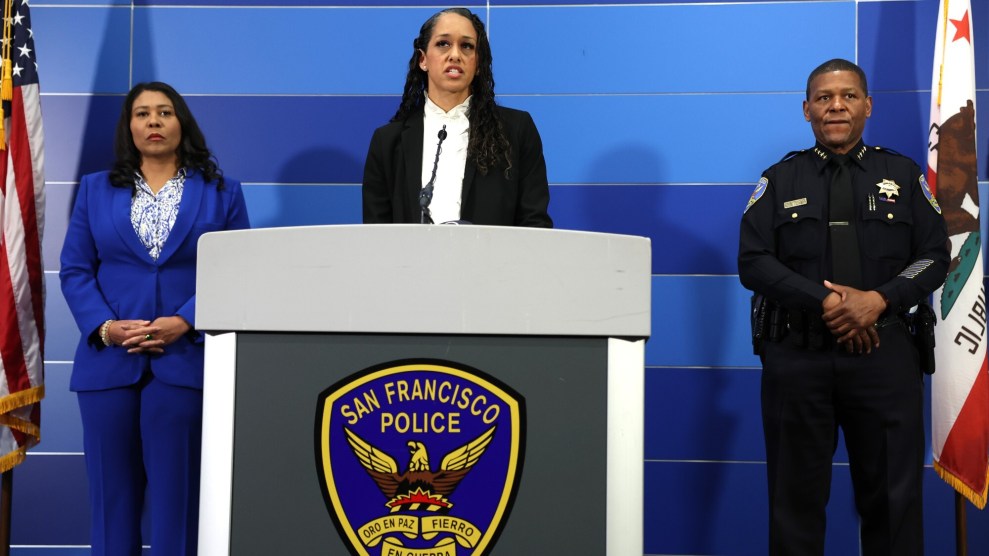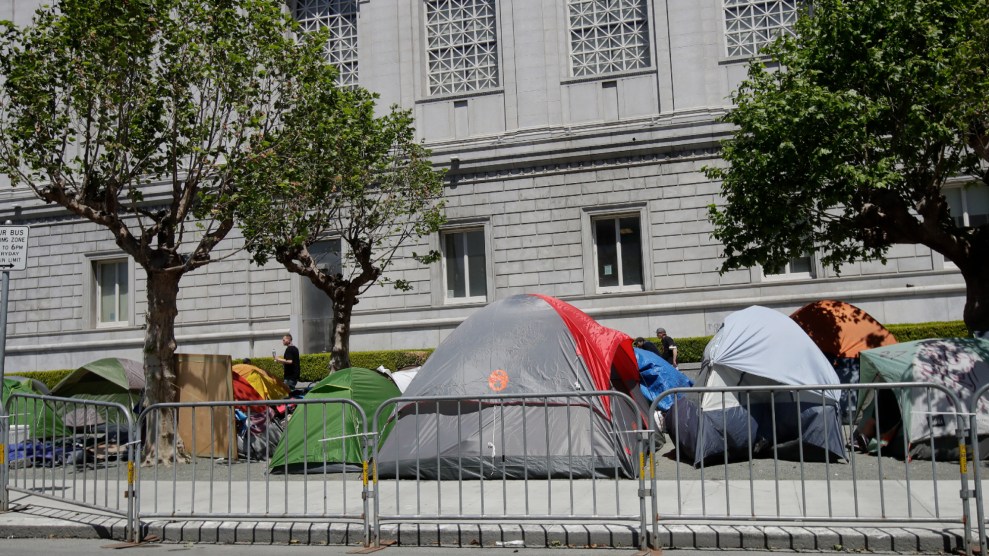
San Francisco Mayor London Breed, DA Brooke Jenkins, and Police Chief Bill Scott.Justin Sullivan/Getty
San Francisco’s public officials and tech execs have been crying for years that the city is becoming more violent: the “reign of criminals who are destroying our city,” Democratic Mayor London Breed said in 2021, ends “when we take the steps to be more aggressive with law enforcement.” When Cash App founder Bob Lee was killed in April, Elon Musk called out the city’s district attorney: “Violent crime in SF is horrific and even if attackers are caught, they are often released immediately. Is the city taking stronger action to incarcerate repeat violent offenders @BrookeJenkinsSF?” Ex-PayPal venture capitalist David Sacks compared Lee’s killing to a Los Angeles case where “a young woman was basically stabbed for no reason by a psychotic homeless person.” But what many assumed was the doing of a random, unhoused person ended in the arrest of a tech professional who knew Lee personally.
In fact, San Francisco has lower than average rates of violent crime compared to other major US cities, and those rates have even decreased further since 2019. But the same old talking points have continued to thrive—and, with another high-profile case, just got worse.
In early April, former San Francisco Fire Commissioner Don Carmignani approached unhoused residents outside his mother’s home in the Marina District, among the city’s most expensive neighborhoods, and told them to leave, later alleging that they had threatened his family. One of those residents, Garett Doty, is accused of then beating Carmignani with a metal rod, from which he suffered injuries including a fractured skull. Carmignani, well respected among city officials and a longtime part of the community, initially got the benefit of the doubt. But as with the killing of Bob Lee, Carmignani’s attack wasn’t exactly what it appeared. Doty’s public defender, releasing video of a similar attack, has tied Carmignani to a string of unsolved attacks on unhoused locals. And police cameras, reports neighborhood outlet Mission Local, recorded Carmignani—who has since missed two court appearances—warning his girlfriend not to speak to investigators.
Surveillance footage from the April 5 incident shows Carmignani approaching an unarmed Doty, first appearing to pepper-spray him, then pursuing him as he walks away. As the San Francisco Standard was publishing that footage, the New York Post released a separate clip of Doty with a crowbar in hand, looking like the instigator. That clip conveniently left out the beginning of the video, which tells a somewhat different story—one that’s allowing Doty and his attorney to claim self-defense.
There’s more. Though it’s true that Carmignani was seriously injured, an exclusive from the Standard includes footage of a 2021 bear-spray attack on a sleeping unhoused man. Doty’s attorney alleges that Carmignani is the attacker in the video, and that the assault was only one of eight linked to Carmignani in the area. Reporting from SFGate also revealed a history of violence: Carmignani retired in 2013 from his position as fire commissioner following an arrest on suspicion of felony domestic violence and criminal threats against his estranged wife. Ultimately, he pleaded guilty to a misdemeanor and had to surrender several firearms, according to SF Weekly.
Earlier this week, Carmignani and his attorney said that the San Francisco District Attorney’s Office planned to drop the case amid “new evidence.” However, the office quickly backtracked, further muddying the details—saying it would still pursue the case, but requesting a delay for the preliminary hearing, citing the severity of Carmignani’s injuries. Carmignani’s decision not to speak to police or testify led on Thursday to Doty’s release from custody.
It’s not the first time this has happened—and whatever happens with Carmignani, it won’t be the last. Conservative outlets would have you believe that San Francisco is in the grip of an epidemic. They’re right: politicians, executives, and often media are driving an epidemic of misplaced blame, framing people with no money or power for the consequences of a tech-fueled housing crisis. Instead of worrying about a boogeyman, perhaps venture capitalists and city officials can worry about crimes against unhoused residents. And perhaps more in the media can, too: you’ll always have your usual suspects—the New York Post, Fox News—but no outlet automatically gets it right, either. (Credit to Mission Local and the Standard, which broke important aspects of these stories and consistently do thoughtful work.)
We as journalists have an obligation to tell the full story. That means holding power to account, not parroting the powerful—especially when they’re blatantly incorrect. In 2022, my colleague Eamon Whalen interviewed a San Francisco public defender on what others miss about “crime wave” narratives:
“There are studies every so often that show public perception of crime far exceeds the reality. We’ve created a culture where there’s extreme bias toward approaches that are employed by these tough on crime types…[People will] point to specific instances of really horrific things that have happened to people and they’ll use them to advance what will ultimately be a much more harmful state of affairs for the people in that jurisdiction. I think that’s a really potentially disastrous consequence.”
Finally, tech execs worried about becoming crime victims certainly don’t have as much cause for concern as the unhoused resident in the Standard‘s video. In San Francisco—which has the highest income inequality of California’s major cities—crime has increased much more in poorer neighborhoods than wealthier ones.














